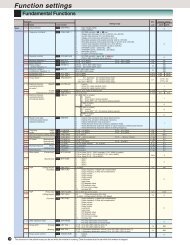You also want an ePaper? Increase the reach of your titles
YUMPU automatically turns print PDFs into web optimized ePapers that Google loves.
15. <strong>Appendix</strong><br />
3.2 Implementation of Noise Prevention Measures<br />
There are two types of noise prevention measures, those that correspond to the propagation route and<br />
those that counteract the effect of noise on the receiving side (side that is adversely affected by the noise).<br />
The basic measure to lessen the effect of noise on the receiving side is to:<br />
1) Separate the main circuit wiring from the control circuit wiring, making it more difficult to receive<br />
noise.<br />
The basic measures to lessen the effect of noise on the generating side are to:<br />
2) Install a noise filter to reduce the noise level.<br />
3) Apply a metal conduit pipe or metal control panel to confine the noise level, and<br />
4) Apply an insulated transformer for the power supply to cut off the noise propagation route.<br />
Table 1 lists the methods for preventing the noise problems, their goals and the propagation routes.<br />
Next, noise prevention measures are presented for the inverter drive configuration.<br />
(1) Wiring and grounding<br />
Separating the main circuit and control circuit as much as possible, both inside and outside the control<br />
panel, and the use of shielded wire and twisted shielded wire, makes it more difficult to receive noise<br />
and allows wiring distances to be minimized (refer to Figure 7). Take notice that the wiring of the<br />
main circuit and control circuit does not become bundled or parallel wiring.<br />
Figure 7 Method of Separating Wiring<br />
For the main circuit wiring, a metal conduit pipe is used and grounded through a grounding wiring to<br />
prevent noise propagation (refer to Figure 8).<br />
The shield (braided wire) of the shielded wire is securely connected to the base (common) side of the<br />
signal line at only one point to avoid the loop formation resulting from a multi-point connection (refer to<br />
Figure 9).<br />
The grounding is effective to not only to reduce the risk of electric shocks, but also to block noise<br />
penetration and radiation. Corresponding to the main circuit voltage, the grounding work should be No. 3<br />
grounding work (300V AC or less) and special No. 3 grounding work (300 to 600V AC). Each ground<br />
wire is to be provided with its own ground or separately wired to a grounding point.<br />
Figure 8 Grounding of Metal Conduit Pipe Figure 9 Treatment of Braided Wire of<br />
Shielded Wire<br />
15-5



